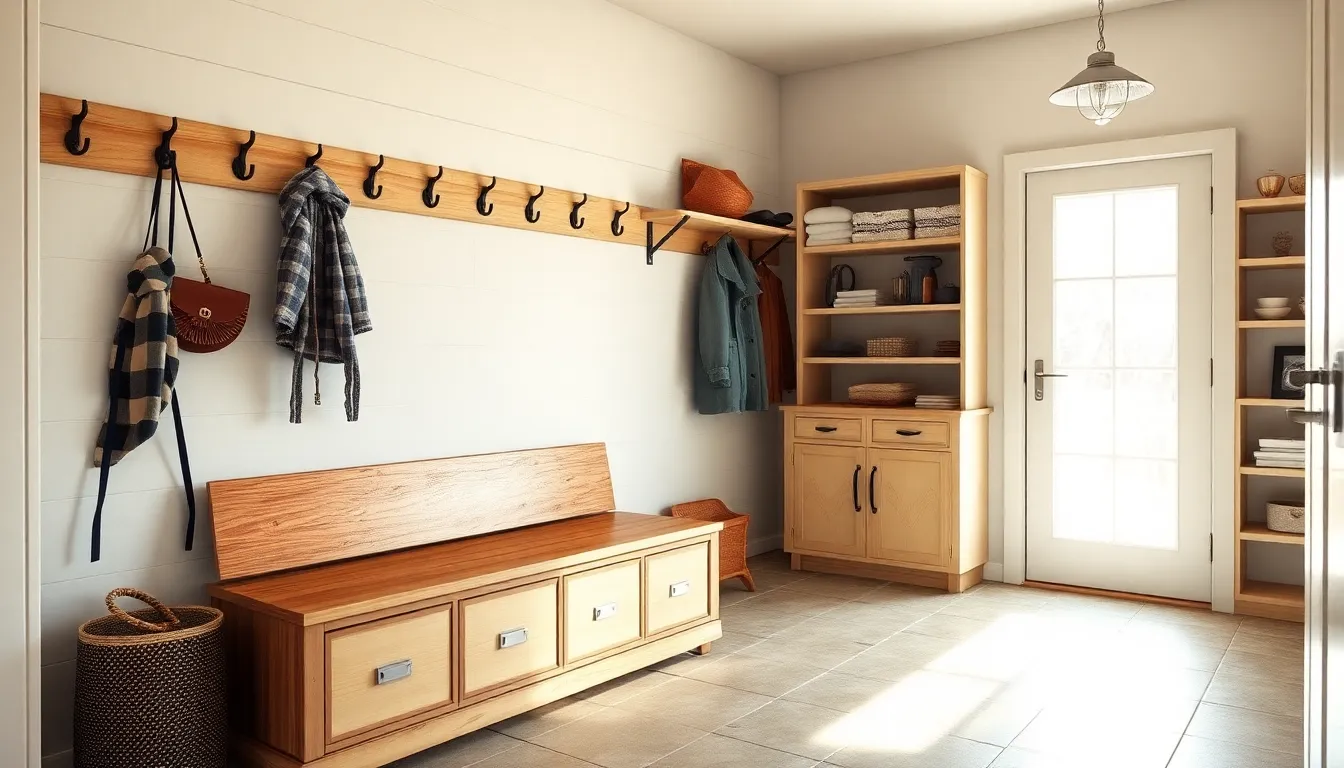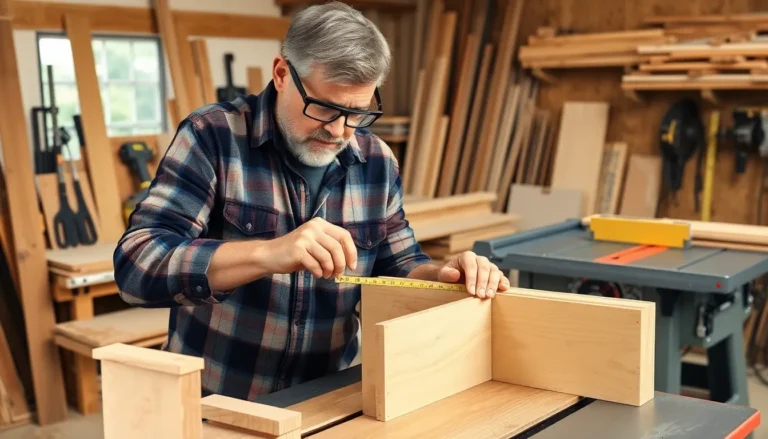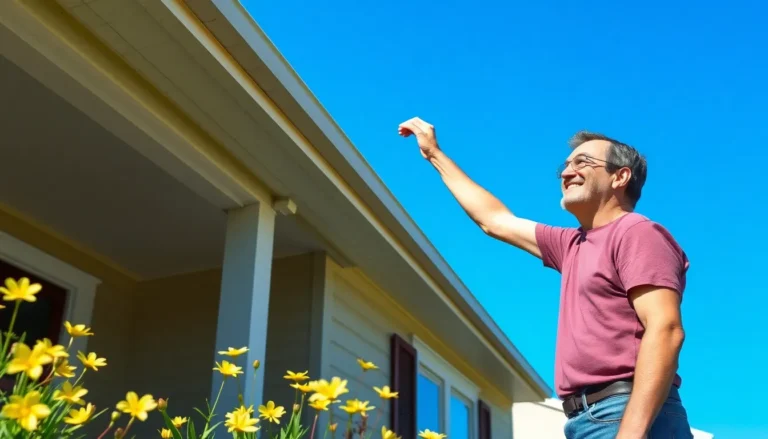A mudroom might not sound like the most glamorous space in the house, but it’s the unsung hero of home organization. Imagine a place where shoes don’t track dirt through the living room and coats don’t end up draped over every available surface. With a little creativity and some DIY spirit, transforming that neglected corner of the entryway into a stylish mudroom is easier than you think.
Picture this: a space that not only keeps chaos at bay but also adds charm to your home. From clever storage solutions to eye-catching decor, DIY mudroom design can be both functional and fun. So roll up those sleeves and prepare to turn your home’s first impression into a masterpiece that even the messiest of family members can appreciate. Who knew that a little mud could lead to such a polished outcome?
Table of Contents
ToggleUnderstanding DIY Mudroom Design
DIY mudroom design focuses on creating a functional and appealing space for organizing entryway essentials. A thoughtfully designed mudroom enhances household efficiency and aesthetics.
Importance of a Mudroom
A mudroom serves a vital role in maintaining home cleanliness. By providing a designated area for outerwear and shoes, it prevents dirt and debris from spreading into living spaces. This essential room accommodates family members, allowing for organized storage and efficient transitions between indoor and outdoor environments. Families benefit significantly from incorporating a mudroom, as it supports a clutter-free home.
Key Features of a Functional Mudroom
Various features contribute to a well-functioning mudroom. Storage solutions like lockers and shelves offer ample space for shoes, bags, and coats. Benches create seating for easier shoe removal, promoting comfort during busy mornings. Hooks or racks facilitate convenient access to outerwear. Well-placed lighting improves visibility, making the space inviting and functional. Additionally, incorporating durable materials ensures longevity, catering to high-traffic areas that see daily use.
Planning Your DIY Mudroom

Planning a DIY mudroom requires careful consideration of several factors to create an efficient space. A well-thought-out design maximizes utility while maintaining style.
Assessing Your Space
Assess the entryway dimensions to determine the best layout for the mudroom. Identify potential areas for storage solutions, such as benches, hooks, and shelves. Ensure that the design accommodates traffic patterns, allowing easy movement without obstruction. Consider natural light sources when positioning elements. If the space permits, integrating built-in features can enhance functionality and aesthetics. Evaluate how existing electrical outlets can support lighting or charging stations. Prioritize a practical arrangement that aligns with daily routines.
Choosing the Right Materials
Choosing durable materials ensures the mudroom withstands high foot traffic and varying weather conditions. Select flooring options like tile or luxury vinyl for easy cleaning and durability. Utilize water-resistant finishes for cabinetry to prevent damage from moisture. Opt for storage solutions made of sturdy wood or metal, maintaining structural integrity over time. Look for hooks and hardware that can handle heavy coats and bags without bending. When selecting colors and textures, aim for a cohesive look that matches the home’s overall style. This attention to material choice can enhance the mudroom’s longevity and aesthetic appeal.
Essential Elements of DIY Mudroom Design
A well-designed mudroom incorporates multiple essential elements to maximize functionality and aesthetics. Integrating practical storage solutions, comfortable seating, and suitable flooring and lighting ensures a welcoming and organized entryway.
Storage Solutions
Incorporating storage solutions remains crucial for an effective mudroom. Lockers provide individual spaces for coats and bags, preventing clutter. Shelves can hold bins for shoes and accessories, keeping the floor clear of debris. Hooks installed at varying heights allow children and adults to hang outerwear easily. Consider incorporating cabinets for additional concealed storage, which keeps items out of sight. Combining these elements offers a tidy and organized appearance while making it simple to find essentials.
Bench and Seating Options
Choosing bench and seating options enhances mudroom usability. A sturdy bench offers a convenient spot for putting on and taking off shoes. Choosing a bench with built-in storage maximizes space and provides extra seating for family members. Seat cushions add comfort and can match the mudroom’s color scheme. Depending on the available space, built-in seating areas can utilize corners effectively. These seating solutions support an organized atmosphere, allowing for smooth transitions in and out of the home.
Flooring and Lighting Considerations
Selecting appropriate flooring and lighting greatly impacts mudroom functionality. Durable flooring materials like tile or luxury vinyl stand up to heavy foot traffic and spills. Waterproof finishes on cabinetry ensure longevity in high-moisture environments. Lighting plays a vital role in creating an inviting space; overhead fixtures and wall sconces can brighten the area. Incorporating natural light through windows or transom designs enhances visibility and warmth. These considerations create a welcoming environment while ensuring practical solutions for daily use.
Popular DIY Mudroom Design Ideas
Finding the right design for a mudroom enhances its functionality and aesthetic appeal. Various styles cater to different tastes and requirements.
Rustic Style
Rustic mudroom designs often feature reclaimed wood and earthy tones. By incorporating natural materials, this design creates a warm and inviting atmosphere. Storage options like wooden benches and open shelves blend seamlessly into the rustic theme. Metal hooks add a touch of industrial charm, ensuring durability and style. Pieces can include woven baskets, providing a practical yet appealing way to organize accessories.
Modern Minimalist
A modern minimalist approach emphasizes simplicity and clean lines. Use neutral palettes and uncluttered spaces to achieve a sleek design. Built-in storage solutions maximize space and minimize visual clutter. Choose functional furniture like streamlined benches that complement the overall aesthetic. Accent lighting can highlight essential features without overwhelming the space. Integrating smart home technology enhances usability and efficiency in this contemporary design.
Family-Friendly Designs
Family-friendly mudroom designs prioritize both practicality and comfort. Soft seating options, like plush benches, encourage ease while taking off shoes. Incorporating child-friendly storage solutions, such as lower hooks and cubbies, ensures children can access their belongings. Durable materials withstand everyday wear and tear, making the space suitable for busy households. Include ample lighting and bright colors to create a cheerful environment. Thoughtful organization systems keep the area tidy, supporting an efficient entryway for the entire family.
A DIY mudroom can transform an entryway into a practical and stylish space. By thoughtfully planning and incorporating essential features like storage solutions and comfortable seating, anyone can create a welcoming environment that enhances home organization.
Whether opting for a rustic charm or a modern minimalist look, the right design choices can make a significant difference. Investing time and effort into this often-overlooked area not only boosts functionality but also elevates the overall aesthetic of the home.
Ultimately, a well-designed mudroom serves as a valuable asset for maintaining cleanliness and order, making it a worthwhile project for any homeowner.



